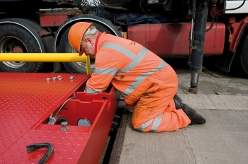A popular question we get asked is “how to bring a mothballed weighbridge back to operation?” Well here’s the answer.
If the correct preventative measures were taken at the time of closing down a weighbridge, there should be no real reason why it cannot be bought back to full operation. Even if it was simply abandoned, it may well be possible to reopen it. This could save the cost of investing in a brand-new system.
Check the pit

The biggest potential problem to be faced with a disused weighbridge is a build up of mud, slurry and water. If the weighbridge is pit mounted, a full inspection of the pit, load-cells and associated parts will need to be arranged.
It is necessary to ensure that the drainage system is not clogged up. It should also be checked that any water and debris can drain away. The pit walls should also be checked for any bulging and seepage.
If the weighbridge does need cleaning out, the operator needs to take into account the fact that waste can produce methane and other dangerous gases. It is necessary, therefore, to check for these gases using suitably certified gas detectors, both before and during such work.
Loading up
If the weighbridge was properly mothballed, the load-cells and cabling will have been stored. They will now need inspecting and testing before they are reinstalled.
If the weighbridge was simply abandoned this will still apply. However, there may be a need to invest in new parts.
Checking the structure
Next, the physical structure of the weighbridge should be examined. Most weighbridges are constructed from steel and will need to be checked for rust. This is particularly true if the weighbridge has been left sitting in water and the protective coating has worn away. Equally, the girder timbers will also need inspecting, as will any mechanical parts. If the weighbridge is surface mounted, the state of the safety barriers will also need to be checked.
Other equipment that will need to be inspected includes electrical junction boxes, barriers, card readers, remote displays, driver-operated panels etc.
Clearly, the best advice is to call in a professional service provider. They can run through all of these checks on behalf of the operator. It is also worth planning this well in advance of any planned opening. This allows any remedial repair work to be completed in good time.
Accurate reporting
Having checked the weighbridge mechanically and electrically, it is still necessary for it to be calibrated and re-verified before it can be used as a ‘legal for trade’ scale.
Operators should ask their chosen service provider about their calibration service. It is important to use an accredited verification engineer who can verify a weighbridge for trade use in order to satisfy trading standards.
The actual calibration will involve the use of a vehicle test unit. By way of illustration, Avery Weigh-Tronix have eight specialist test units, four of which can calibrate up to 48 tonnes and four up to 44 tonnes.
As part of this calibration process the engineer will complete a number of checks across the weighing platform to ensure accurate weighing, including performing an end-middle-end test. This will ensure that the weighbridge weighs a load accurately wherever a vehicle is positioned upon it.
Ongoing service and maintainence
Once calibrated and verified as legal for trade, the weighbridge can then be brought back into use.
This, however, should not be the end of the story. Operators should make sure that the weighbridge continues to operate reliably so that they can avoid any unwanted downtime in the future.
Again, the best advice is to talk to a service provider who can advise on both a service and calibration schedule, and highlight the tasks that the operator can undertake to help ensure the ongoing smooth running of their weighbridge.
A weighbridge represents a large capital investment, so it makes sense to bring existing hardware back into action where possible and then implement a planned weighbridge service schedule to keep it up and running.

 United States
United States  Canada
Canada  Canada (fr)
Canada (fr)  India
India  Malaysia
Malaysia  Ireland
Ireland